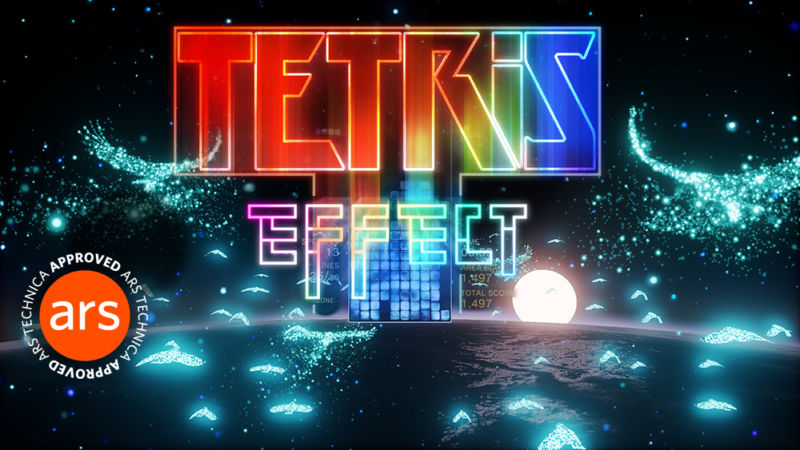
Before I began playing this week's new game, Tetris Effect, I found myself tempted to compare it to other versions of the puzzle series. That's an easy trap to fall into—a bullet-point sorting of tweaks, features, and differences—and one that gets pretty unwieldy with decades of Tetris games to compare to.
But shortly after I dove into Tetris Effect, with a PlayStation VR headset firmly strapped to my head, my thinking about this game drifted somewhere surprising: not to another game or sequel, but to an event. Specifically, I thought of the latest Classic Tetris World Championship, held in Portland, Oregon, in October.
There, a 16-year-old named Joseph Saelee rocked the gaming world by besting seasoned veterans of the game's 1989 NES version and winning it all. You've seen Tetris before, but never like this—with a multi-camera rig showing pros' gamer faces as they pound through ultra-fast sessions in incredible fashion (aided in no small part by a "hyper-tapping" technique used to keep sessions going beyond that version's "kill screen"). I'll never forget what I saw. What unfolded was not revolutionary, but its presentation, drama, and feeling of an oldie born anew made the competition particularly thrilling to watch.
That level of exhilaration—of the familiar and the astounding slamming together, all wrapped in a blanket of tetrads—can also be found in Tetris Effect. That speaks to the game's brilliant guiding principle: not to outdo Tetris but to newly celebrate it. In October, I watched Saelee emerge as a victor, then awkwardly hold a tetrad-shaped trophy in the air while fighting through tears, clearly beside himself. The closest I may ever get to matching Saelee's emotional state has come from playing Tetris Effect.
Subconscious-molding potential
That's not to say this game doesn't establish some intriguing tweaks and changes to what has come before in dropping-block video games. But any conversation about Tetris Effect should start with a focus on the word "Effect" in the title.
Enhance Games' recent Tetris press tour included stories about the series' hypnotic effect on the human brain, whether via anecdotes or formal research. The phenomenon of closing your eyes and seeing endless falling Tetris shapes or feeling like the gameplay has invaded your dreams (or sometimes nightmares) has been explored to some extent in scientific study. Researchers have even explored how amnesia sufferers have retained Tetris-related information after playing the game at length.In an interview, producer Tetsuya Mizuguchi confirmed to Ars that he wanted to make an official Tetris game for years. He had even tried securing the series' license before developing rhythmic puzzle games like Lumines and Meteos in the early '00s. Those series revolve around levels where the blocks, backgrounds, music, and sound effects sync together; in Lumines' case, that aesthetic touch also impacts gameplay, as a timing meter determines exactly how you drop and break the game's puzzle blocks.
-
Many screens are captured from live VR gameplay. As such, the Tetris grid looks tiny. Trust me: it looks the right size in VR (and you can zoom the Tetris board in and out as you see fit, whether in VR or not).
-
Turning my head to the right, I can get a better look at the moon buggy coming my way. Heya, guy.
-
And this is the same moon zone, only now exploding with particle effects because I cleared a group of lines.
-
Here's another gorgeous VR level transition. Before: you're apparently underground, with only a sliver of light peeking through.
-
After: the sand ceiling opens up, revealing more light and detail all around.
-
Gorgeous rooms in which to play Tetris.
-
Changes in weather.
-
More line-clearing sparkles as we float in space.
-
This is a tease of the game's 30+ "Journey" level selection. (Some later ones are hidden in this view.)
Tetris Effect, then, marries Mizuguchi's sights-and-sounds design philosophy with the subconscious-molding potential of Tetris. If we all see Tetris in the corners of our mind's eye—in the milky blackness of sleep and dreams and meditation—then why not emulate that powerful feeling within a standalone game?
Whether you play Tetris Effect in VR or on a standard TV, you can still look forward to a game that largely resembles other standard, old-school Tetris games. Meaning, players will focus their attention on a standard, 2D board of falling pieces (10 blocks wide, 20 blocks tall), as opposed to a jigsaw-styled mess of 3D pieces a la Tetrisphere.
In VR, the standard Tetris board appears at a distance I'd call roughly an arm's reach away, while that board fills the middle of a TV screen in 2D mode. (In both cases, you can adjust exactly how zoomed-in the primary board appears, either via pre-game menus or by pressing a joystick in the middle of a live session.) Where Tetris Effect differs is how it fills the virtual space all around the board, whether within VR or on a TV screen. A clear vision cone means you'll never lose sight of the board and its falling blocks, but the entire periphery—everything above, below, and around—can either sparkle with particle effects or erupt with elements like creatures, airplanes, and distant planets.
In our review period, we unearthed roughly 33 playfields (known as "skins"), and these impact your gameplay more like Meteos than Lumines. The visuals, block shapes, colors, sound effects, and music are all tied together, but they don't impact the basic gameplay. Tetrads fit together and fall down the same way in the aquarium level as they do in the sweeping-desert one.
https://arstechnica.com/gaming/2018/11/tetris-effect-uses-vr-to-drop-puzzle-pieces-directly-into-your-brain/Bagikan Berita Ini















0 Response to "Tetris Effect review: The puzzle game of my dreams—literally"
Post a Comment